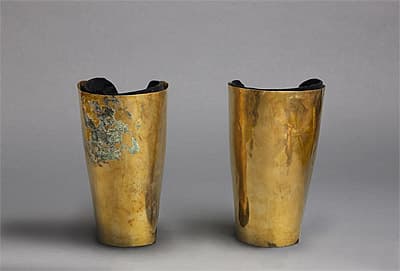SICÁN-LAMBAYEQUE culture North coast 750 – 1375 AD
Pair of calf guards 900-1100 AD gold , rolling, contouring, perforations21.7 (h) cm 12.7 cm (diameter) Museo Nacional Sicán, Ferreñafe Photograph: Daniel Giannoni
Like many artefacts made by the goldsmiths of Sicán, these pieces of body armour were probably made to be shown off in spectacular ceremonies, after which they would accompany their owner in the tomb. Because of their function, the calf guards closely resemble the Incan gold bracelets (cat. 193)—rolled and cut metal sheets shaped to fit around human limbs. Here, each piece has seven holes pierced along its outer vertical edge, in order to allow it to be laced around the leg. They were part of a cache excavated ‘in 1992 by the Proyecto Arqueológico Sicán of the eastern tomb at Huaca Loro, or Oro, at the Santuario Histórico de Pómac’1 (along with cats 108–116, 129).
The mass production of metal objects was facilitated by technological advances such as the development of tumbaga and other alloys of gold, silver, copper and tin. At Batán Grande, all necessary components were available: ‘minerals, fuel, smelting furnaces, and workshops for forging, hammering and embossing.’2 Objects were made mainly at Cerro Huaringa, which was ‘a huge copper alloy industrial center where at least two workshops with many smelting furnaces were built’.3 Pure gold was preferred, as it does not change much, whereas alloys with silver and copper can oxidise or crystallise.
Christine Dixon
1. Luisa María Vetter Parodi, cats 148 and 149, in Paloma Carcedo de Mufarech (ed.),
Inca: Origins and mysteries of the civilisation of gold, Venice: Marsilio 2010, p. 225.
2. María Inés Velarde and Pamela Castro de la Mata, ‘The ideology and technology of metals in ancient, pre-Incan Peru’, in Carcedo de Mufarech (ed.), p. 46.
3. Rebecca R. Stone, Art of the Andes from Chavín to Inca, London: Thames and Hudson 1995, 3rd edn 2013, p. 166.
Like many artefacts made by the goldsmiths of Sicán, these pieces of body armour were probably made to be shown off in spectacular ceremonies, after which they would accompany their owner in the tomb. Because of their function, the calf guards closely resemble the Incan gold bracelets (cat. 193)—rolled and cut metal sheets shaped to fit around human limbs. Here, each piece has seven holes pierced along its outer vertical edge, in order to allow it to be laced around the leg. They were part of a cache excavated ‘in 1992 by the Proyecto Arqueológico Sicán of the eastern tomb at Huaca Loro, or Oro, at the Santuario Histórico de Pómac’1 (along with cats 108–116, 129).
The mass production of metal objects was facilitated by technological advances such as the development of tumbaga and other alloys of gold, silver, copper and tin. At Batán Grande, all necessary components were available: ‘minerals, fuel, smelting furnaces, and workshops for forging, hammering and embossing.’2 Objects were made mainly at Cerro Huaringa, which was ‘a huge copper alloy industrial center where at least two workshops with many smelting furnaces were built’.3 Pure gold was preferred, as it does not change much, whereas alloys with silver and copper can oxidise or crystallise.
Christine Dixon
1. Luisa María Vetter Parodi, cats 148 and 149, in Paloma Carcedo de Mufarech (ed.),
Inca: Origins and mysteries of the civilisation of gold, Venice: Marsilio 2010, p. 225.
2. María Inés Velarde and Pamela Castro de la Mata, ‘The ideology and technology of metals in ancient, pre-Incan Peru’, in Carcedo de Mufarech (ed.), p. 46.
3. Rebecca R. Stone, Art of the Andes from Chavín to Inca, London: Thames and Hudson 1995, 3rd edn 2013, p. 166.
Like many artefacts made by the goldsmiths of Sicán, these pieces of body armour were probably made to be shown off in spectacular ceremonies, after which they would accompany their owner in the tomb. Because of their function, the calf guards closely resemble the Incan gold bracelets (cat. 193)—rolled and cut metal sheets shaped to fit around human limbs. Here, each piece has seven holes pierced along its outer vertical edge, in order to allow it to be laced around the leg. They were part of a cache excavated ‘in 1992 by the Proyecto Arqueológico Sicán of the eastern tomb at Huaca Loro, or Oro, at the Santuario Histórico de Pómac’1 (along with cats 108–116, 129).
The mass production of metal objects was facilitated by technological advances such as the development of tumbaga and other alloys of gold, silver, copper and tin. At Batán Grande, all necessary components were available: ‘minerals, fuel, smelting furnaces, and workshops for forging, hammering and embossing.’2 Objects were made mainly at Cerro Huaringa, which was ‘a huge copper alloy industrial center where at least two workshops with many smelting furnaces were built’.3 Pure gold was preferred, as it does not change much, whereas alloys with silver and copper can oxidise or crystallise.
Christine Dixon
1. Luisa María Vetter Parodi, cats 148 and 149, in Paloma Carcedo de Mufarech (ed.),
Inca: Origins and mysteries of the civilisation of gold, Venice: Marsilio 2010, p. 225.
2. María Inés Velarde and Pamela Castro de la Mata, ‘The ideology and technology of metals in ancient, pre-Incan Peru’, in Carcedo de Mufarech (ed.), p. 46.
3. Rebecca R. Stone, Art of the Andes from Chavín to Inca, London: Thames and Hudson 1995, 3rd edn 2013, p. 166.


